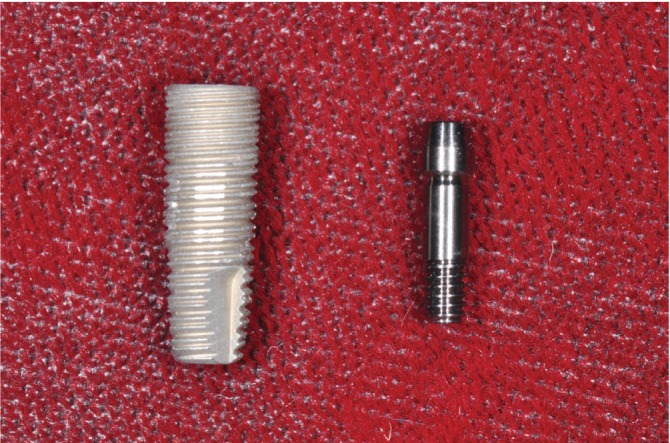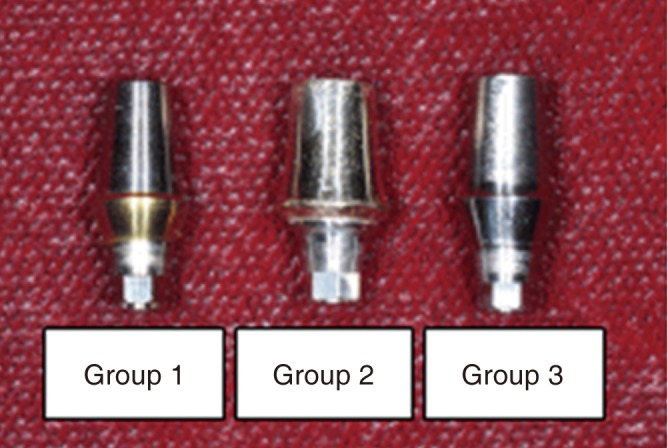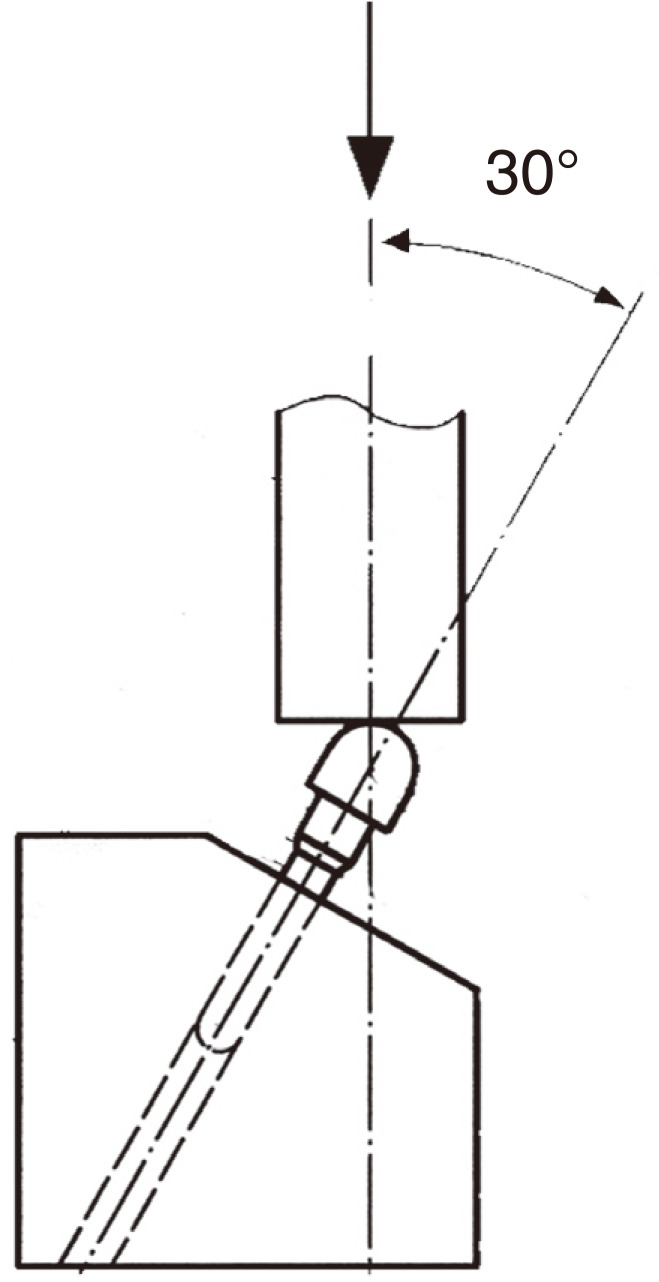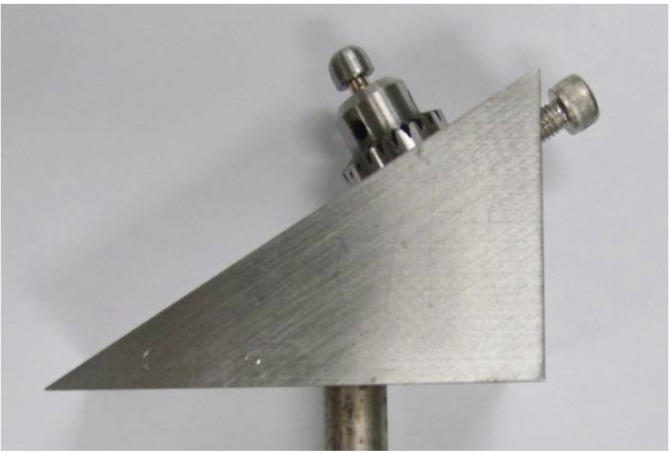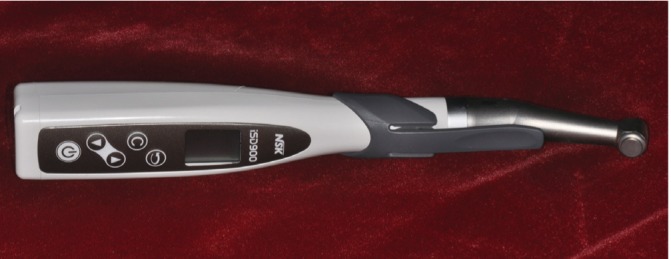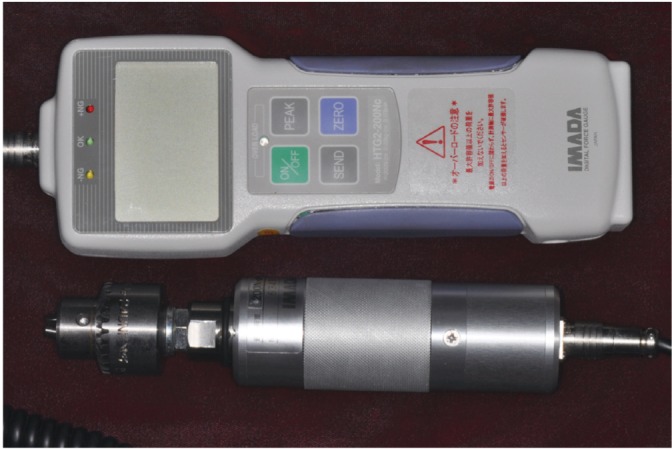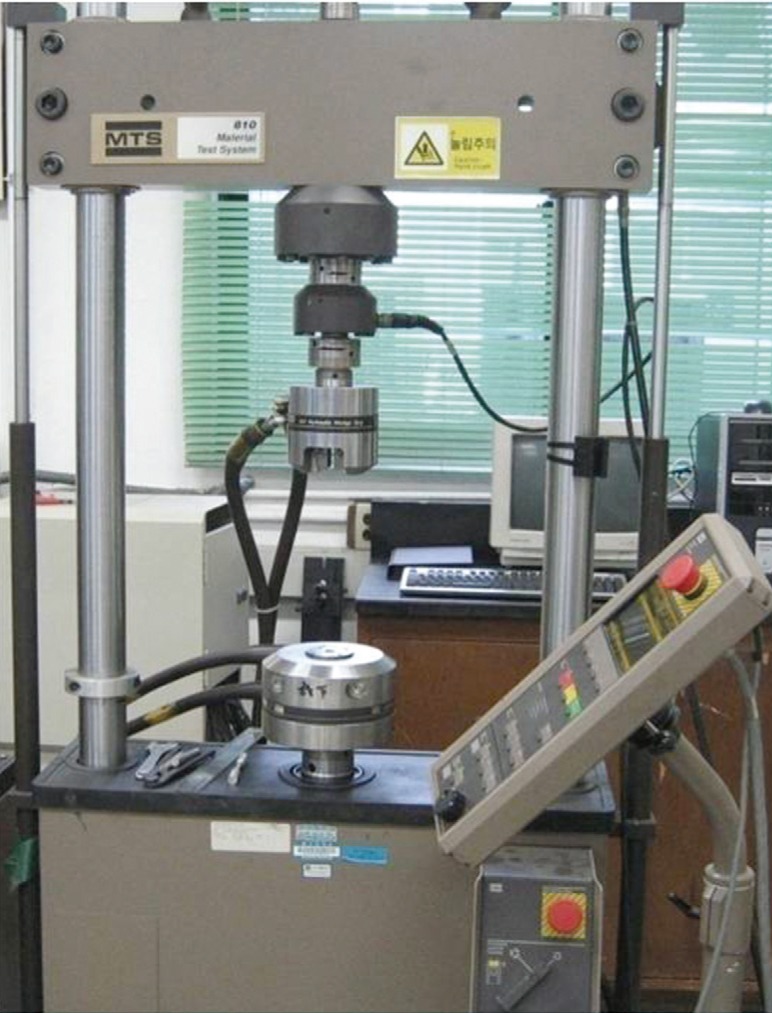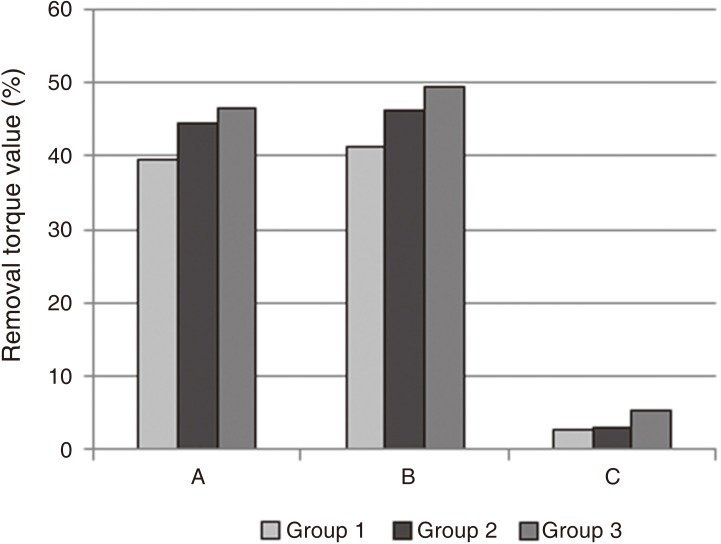J Adv Prosthodont.
2013 Feb;5(1):21-28. 10.4047/jap.2013.5.1.21.
Influence of the implant abutment types and the dynamic loading on initial screw loosening
- Affiliations
-
- 1Department of Prosthodontics, College of Dentistry, Dankook University, Cheonan, Republic of Korea. syshin@dankook.ac.kr
- KMID: 2284768
- DOI: http://doi.org/10.4047/jap.2013.5.1.21
Abstract
- PURPOSE
This study examined the effects of the abutment types and dynamic loading on the stability of implant prostheses with three types of implant abutments prepared using different fabrication methods by measuring removal torque both before and after dynamic loading.
MATERIALS AND METHODS
Three groups of abutments were produced using different types of fabrication methods; stock abutment, gold cast abutment, and CAD/CAM custom abutment. A customized jig was fabricated to apply the load at 30degrees to the long axis. The implant fixtures were fixed to the jig, and connected to the abutments with a 30 Ncm tightening torque. A sine curved dynamic load was applied for 10(5) cycles between 25 and 250 N at 14 Hz. Removal torque before loading and after loading were evaluated. The SPSS was used for statistical analysis of the results. A Kruskal-Wallis test was performed to compare screw loosening between the abutment systems. A Wilcoxon signed-rank test was performed to compare screw loosening between before and after loading in each group (alpha=0.05).
RESULTS
Removal torque value before loading and after loading was the highest in stock abutment, which was then followed by gold cast abutment and CAD/CAM custom abutment, but there were no significant differences.
CONCLUSION
The abutment types did not have a significant influence on short term screw loosening. On the other hand, after 10(5) cycles dynamic loading, CAD/CAM custom abutment affected the initial screw loosening, but stock abutment and gold cast abutment did not.
Keyword
MeSH Terms
Figure
Cited by 1 articles
-
Effects of grooved abutment on stability of implant abutment screw
Il-Gwang Sim, Seung-Won Yang, June-Sung Shim, Jee-Hwan Kim
J Korean Acad Prosthodont. 2016;54(4):387-392. doi: 10.4047/jkap.2016.54.4.387.
Reference
-
1. Schmitt A, Zarb GA. The longitudinal clinical effectiveness of osseointegrated dental implants for single-tooth replacement. Int J Prosthodont. 1993; 6:197–202. PMID: 8329098.2. Wannfors K, Smedberg JI. A prospective clinical evaluation of different single-tooth restoration designs on osseointegrated implants. A 3-year follow-up of Brånemark implants. Clin Oral Implants Res. 1999; 10:453–458. PMID: 10740454.
Article3. Laney WR, Jemt T, Harris D, Henry PJ, Krogh PH, Polizzi G, Zarb GA, Herrmann I. Osseointegrated implants for single-tooth replacement: progress report from a multicenter prospective study after 3 years. Int J Oral Maxillofac Implants. 1994; 9:49–54. PMID: 8150512.4. Jemt T, Pettersson P. A 3-year follow-up study on single implant treatment. J Dent. 1993; 21:203–208. PMID: 8354744.
Article5. Kang YM, Lim JH, Cho IH. A study on the abutment screw loosening of dental implants. J Korean Acad Prosthodont. 1996; 34:1–14.6. Lazzara R, Siddiqui AA, Binon P, Feldman SA, Weiner R, Phillips R, Gonshor A. Retrospective multicenter analysis of 3i endosseous dental implants placed over a five-year period. Clin Oral Implants Res. 1996; 7:73–83. PMID: 9002825.
Article7. Jörnéus L, Jemt T, Carlsson L. Loads and designs of screw joints for single crowns supported by osseointegrated implants. Int J Oral Maxillofac Implants. 1992; 7:353–359. PMID: 1289261.8. Burguete RL, Johns RB, King T, Patterson EA. Tightening characteristics for screwed joints in osseointegrated dental implants. J Prosthet Dent. 1994; 71:592–599. PMID: 8040822.
Article9. Haack JE, Sakaguchi RL, Sun T, Coffey JP. Elongation and preload stress in dental implant abutment screws. Int J Oral Maxillofac Implants. 1995; 10:529–536. PMID: 7590997.10. Martin WC, Woody RD, Miller BH, Miller AW. Implant abutment screw rotations and preloads for four different screw materials and surfaces. J Prosthet Dent. 2001; 86:24–32. PMID: 11458261.
Article11. Cibirka RM, Nelson SK, Lang BR, Rueggeberg FA. Examination of the implant-abutment interface after fatigue testing. J Prosthet Dent. 2001; 85:268–275. PMID: 11264934.
Article12. Sawase T, Wennerberg A, Hallgren C, Albrektsson T, Baba K. Chemical and topographical surface analysis of five different implant abutments. Clin Oral Implants Res. 2000; 11:44–50. PMID: 11168193.
Article13. Heydecke G, Sierraalta M, Razzoog ME. Evolution and use of aluminum oxide single-tooth implant abutments: a short review and presentation of two cases. Int J Prosthodont. 2002; 15:488–493. PMID: 12375466.14. Wood MR, Vermilyea SG. Committee on Research in Fixed Prosthodontics of the Academy of Fixed Prosthodontics. A review of selected dental literature on evidence-based treatment planning for dental implants: report of the Committee on Research in Fixed Prosthodontics of the Academy of Fixed Prosthodontics. J Prosthet Dent. 2004; 92:447–462. PMID: 15523334.
Article15. Priest G. Virtual-designed and computer-milled implant abutments. J Oral Maxillofac Surg. 2005; 63:22–32. PMID: 16125013.
Article16. Ortorp A, Jemt T, Bäck T, Jälevik T. Comparisons of precision of fit between cast and CNC-milled titanium implant frameworks for the edentulous mandible. Int J Prosthodont. 2003; 16:194–200. PMID: 12737254.17. Al-Fadda SA, Zarb GA, Finer Y. A comparison of the accuracy of fit of 2 methods for fabricating implant-prosthodontic frameworks. Int J Prosthodont. 2007; 20:125–131. PMID: 17455431.18. Oh BD, Choi YS, Shin SY. The effect of types of abutment and dynamic loading on microgap between implant fixture and abutment. J Dent Rehabil Appl Sci. 2010; 26:389–403.19. Kapos T, Ashy LM, Gallucci GO, Weber HP, Wismeijer D. Computer-aided design and computer-assisted manufacturing in prosthetic implant dentistry. Int J Oral Maxillofac Implants. 2009; 24:110–117. PMID: 19885438.20. Schwarz MS. Mechanical complications of dental implants. Clin Oral Implants Res. 2000; 11:156–158. PMID: 11168264.
Article21. Binon PP. Evaluation of machining accuracy and consistency of selected implants, standard abutments, and laboratory analogs. Int J Prosthodont. 1995; 8:162–178. PMID: 7575968.22. Merz BR, Hunenbart S, Belser UC. Mechanics of the implant-abutment connection: an 8-degree taper compared to a butt joint connection. Int J Oral Maxillofac Implants. 2000; 15:519–526. PMID: 10960985.23. Norton MR. An in vitro evaluation of the strength of an internal conical interface compared to a butt joint interface in implant design. Clin Oral Implants Res. 1997; 8:290–298. PMID: 9586476.
Article24. Weiss EI, Kozak D, Gross MD. Effect of repeated closures on opening torque values in seven abutment-implant systems. J Prosthet Dent. 2000; 84:194–199. PMID: 10946337.
Article25. Norton MR. Assessment of cold welding properties of the internal conical interface of two commercially available implant systems. J Prosthet Dent. 1999; 81:159–166. PMID: 9922428.
Article26. Balfour A, O'Brien GR. Comparative study of antirotational single tooth abutments. J Prosthet Dent. 1995; 73:36–43. PMID: 7699597.
Article27. Theoharidou A, Petridis HP, Tzannas K, Garefis P. Abutment screw loosening in single-implant restorations: a systematic review. Int J Oral Maxillofac Implants. 2008; 23:681–690. PMID: 18807565.28. Jaarda MJ, Razzoog ME, Gratton DG. Effect of preload torque on the ultimate tensile strength of implant prosthetic retaining screws. Implant Dent. 1994; 3:17–21. PMID: 7920384.
Article29. Siamos G, Winkler S, Boberick KG. Relationship between implant preload and screw loosening on implant-supported prostheses. J Oral Implantol. 2002; 28:67–73. PMID: 12498448.30. Tan KB, Nicholls JI. Implant-abutment screw joint preload of 7 hex-top abutment systems. Int J Oral Maxillofac Implants. 2001; 16:367–377. PMID: 11432656.31. Binon PP, McHugh MJ. The effect of eliminating implant/abutment rotational misfit on screw joint stability. Int J Prosthodont. 1996; 9:511–519. PMID: 9171488.32. Lee J, Kim YS, Kim CW, Han JS. Wave analysis of implant screw loosening using an air cylindrical cyclic loading device. J Prosthet Dent. 2002; 88:402–408. PMID: 12447217.
Article33. Vigolo P, Fonzi F, Majzoub Z, Cordioli G. Evaluation of gold-machined UCLA-type abutments and CAD/CAM titanium abutments with hexagonal external connection and with internal connection. Int J Oral Maxillofac Implants. 2008; 23:247–252. PMID: 18548920.34. Abduo J, Lyons K, Bennani V, Waddell N, Swain M. Fit of screw-retained fixed implant frameworks fabricated by different methods: a systematic review. Int J Prosthodont. 2011; 24:207–220. PMID: 21519567.35. Bates JF, Stafford GD, Harrison A. Masticatory function - a review of the literature III Masticatory performance and efficiency. J Oral Rehabil. 1976; 3:57–67. PMID: 772184.36. Mohl ND, Zarb GA, Carlsson GE, Rugh JD. A textbook of occlusion. 1998. Quintessence pub;p. 148–152.37. Gibbs CH, Mahan PE, Mauderli A, Lundeen HC, Walsh EK. Limits of human bite strength. J Prosthet Dent. 1986; 56:226–229. PMID: 3463748.
Article38. Bae BR, Choi YS, Cho IH. Influence of implant abutment systems on detorque value and screw joint stability. J Dent Rehabil Appl Sci. 2010; 26:97–109.
- Full Text Links
- Actions
-
Cited
- CITED
-
- Close
- Share
- Similar articles
-
- The effect of internal implant-abutment connection and diameter on screw loosening
- A vitro study of retained screw stability by various connection designs between fixture and abutment in implant dentistry
- A study of screw loosening after dynamic continous fatigue test of several abutment screw
- Effect of various abutment systems on the removal torque and the abutment settling in the conical connection implant systems
- Removal torque of a two-piece zirconia abutment with a novel titanium component in an internal connection implant system after dynamic cyclic loading

